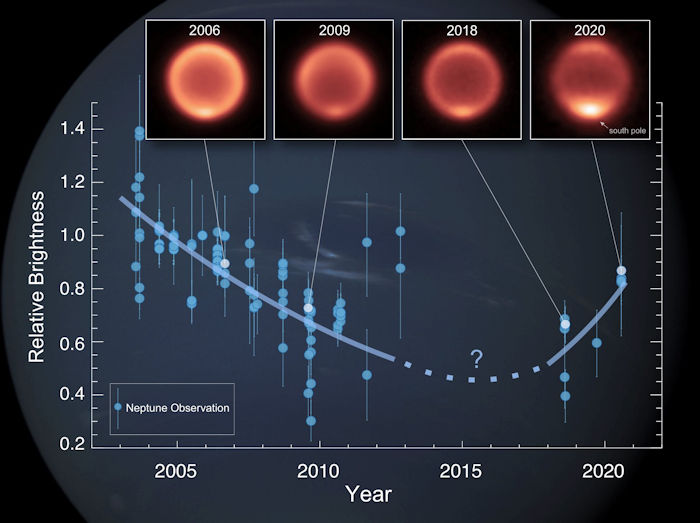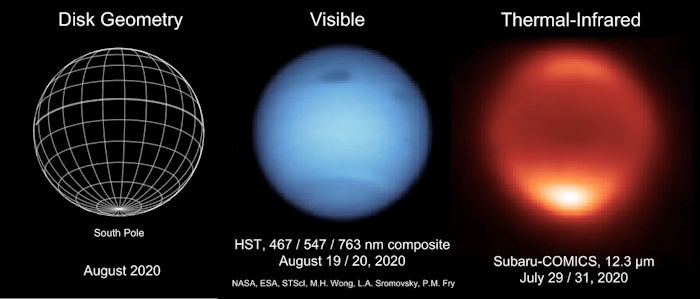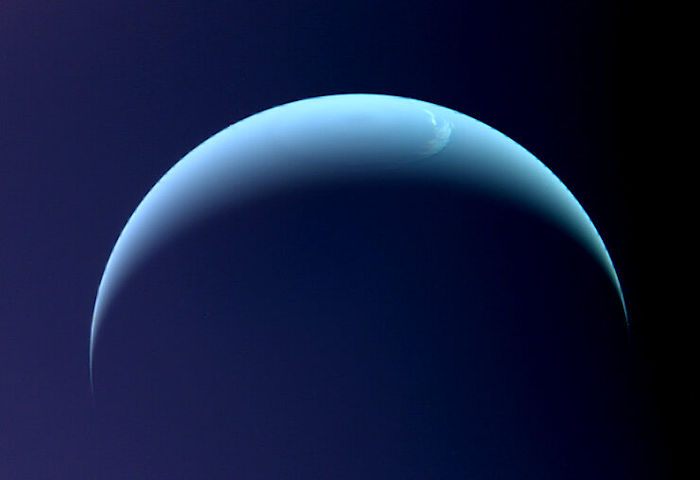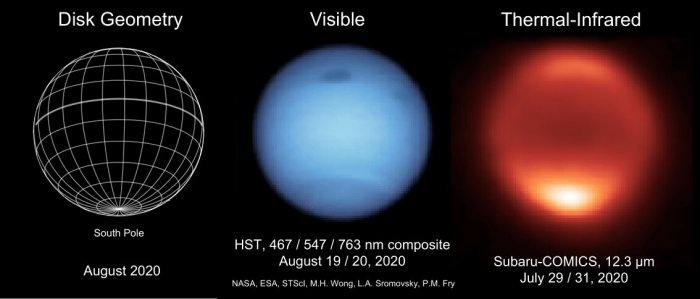Folks , the planet Neptune never fails to surprise , but this surprise is a very pleasant one for our Hollow Planet theory :)) You see , the weather on Neptune's surface is driven primarily by it's inner Sun (as this new evidence confirms) , given the enormous distance from the external Sun to Neptune . Also , notice how the infrared images clearly show that the Polar regions are Hotspots :-
Astronomers Capture Surprising Changes In Neptune’s Temperatures
MessageToEagle | April 13, 2022 | Astronomy |
Eddie Gonzales Jr. – MessageToEagle.com – An international team of astronomers has used ground-based telescopes, including the European Southern Observatory’s Very Large Telescope (ESO’s VLT), to track Neptune’s atmospheric temperatures over a 17-year period. They found a surprising drop in Neptune’s global temperatures followed by a dramatic warming at its south pole.
This composite shows thermal images of Neptune taken between 2006 and 2020. The first three images (2006, 2009, 2018) were taken with the VISIR instrument on ESO’s Very Large Telescope while the 2020 image was captured by the COMICS instrument on the Subaru Telescope (VISIR wasn’t in operation in mid-late 2020 because of the pandemic). After the planet’s gradual cooling, the south pole appears to have become dramatically warmer in the past few years, as shown by a bright spot at the bottom of Neptune in the images from 2018 and 2020. Credit: ESO/M. Roman, NAOJ/Subaru/COMICS
“This change was unexpected,” says Michael Roman, a postdoctoral research associate at the University of Leicester, UK, and lead author of the study published today in The Planetary Science Journal. “Since we have been observing Neptune during its early southern summer, we expected temperatures to be slowly growing warmer, not colder.”
Like Earth, Neptune experiences seasons as it orbits the Sun. However, a Neptune season lasts around 40 years, with one Neptune year lasting 165 Earth years. It has been summertime in Neptune’s southern hemisphere since 2005, and the astronomers were eager to see how temperatures were changing following the southern summer solstice.
Astronomers looked at nearly 100 thermal-infrared images of Neptune, captured over a 17-year period, to piece together overall trends in the planet’s temperature in greater detail than ever before.
Observed changes in Neptune’s thermal-infrared brightness, a measure of temperature in Neptune’s atmosphere. The plot shows the relative change in the thermal-infrared brightness from Neptune’s stratosphere with time for all existing images taken by ground-based telescopes. Brighter images are interpreted as warmer. Corresponding thermal-infrared images (top) at wavelengths of ~12 µm show Neptune’s appearance in 2006, 2009, 2018 (observed by the European Southern Observatory’s Very Large Telescope’s VISIR instrument), and 2020 (observed by Subaru’s COMICS instrument). The south pole appears to have become dramatically warmer in just the past few years. Credit: Michael Roman/NASA/JPL/Voyager-ISS/Justin Cowart.
These data showed that, despite the onset of southern summer, most of the planet had gradually cooled over the last two decades. The globally averaged temperature of Neptune dropped by 8 °C between 2003 and 2018.
The astronomers were then surprised to discover a dramatic warming of Neptune’s south pole during the last two years of their observations, when temperatures rapidly rose 11 °C between 2018 and 2020. Although Neptune’s warm polar vortex has been known for many years, such rapid polar warming has never been previously observed on the planet.
“Our data cover less than half of a Neptune season, so no one was expecting to see large and rapid changes,” says co-author Glenn Orton, senior research scientist at Caltech’s Jet Propulsion Laboratory (JPL) in the US.
The astronomers measured Neptune’s temperature using thermal cameras that work by measuring the infrared light emitted from astronomical objects. For their analysis, the team combined all existing images of Neptune gathered over the last two decades by ground-based telescopes. They investigated infrared light emitted from a layer of Neptune’s atmosphere called the stratosphere. This allowed the team to build up a picture of Neptune’s temperature and its variations during part of its southern summer.
Because Neptune is roughly 4.5 billion kilometers away and is very cold, the planet’s average temperature reaching around –220°C, measuring its temperature from Earth is no easy task. “This type of study is only possible with sensitive infrared images from large telescopes like the VLT that can observe Neptune clearly, and these have only been available for the past 20 years or so,” says co-author Leigh Fletcher, a professor at the University of Leicester.
Neptune as seen in visible light (centre) and thermal-infrared wavelengths (right), in 2020. The centre image combines multiple images from the Hubble Space Telescope, while the thermal-infrared image on the right was taken from the Subaru Telescope on Maunakea, Hawai’i. In the thermal-infrared, Neptune’s warm south pole glows more brightly than ever seen before. Credit: Michael Roman/NASA/ESA/STSci/M.H. Wong/L.A. Sromovsky/P.M. Fry.
Around one third of all the images taken came from the VLT Imager and Spectrometer for mid-InfraRed (VISIR) instrument on ESO’s VLT in Chile’s Atacama Desert. Because of the telescope’s mirror size and altitude, it has a very high resolution and data quality, offering the clearest images of Neptune. The team also used data from NASA’s Spitzer Space Telescope and images taken with the Gemini South telescope in Chile, as well as with the Subaru Telescope, the Keck Telescope, and the Gemini North telescope, all in Hawai’i.
Voyager 2 view of Neptune, captured in August 1989. Credit: NASA/JPL-Caltech/Kevin M. Gill.
Because Neptune’s temperature variations were so unexpected, the astronomers do not know yet what could have caused them. They could be due to changes in Neptune’s stratospheric chemistry, or random weather patterns, or even the solar cycle. More observations will be needed over the coming years to explore the reasons for these fluctuations. Future ground-based telescopes like ESO’s Extremely Large Telescope (ELT) could observe temperature changes like these in greater detail, while the NASA/ESA/CSA James Webb Space Telescope will provide unprecedented new maps of the chemistry and temperature in Neptune’s atmosphere.
“I think Neptune is itself very intriguing to many of us because we still know so little about it,” says Roman. “This all points towards a more complicated picture of Neptune’s atmosphere and how it changes with time.”
Neptune Is Cooler Than We thought – New Observations
MessageToEagle.com | April 15, 2022 | Astronomy |
Eddie Gonzales Jr. – MessageToEagle.com – New research led by space scientists at the University of Leicester has revealed how temperatures in Neptune’s atmosphere have unexpectedly fluctuated over the past two decades.
In a new study, researchers used observations in thermal-infrared wavelengths beyond the visible light spectrum, effectively sensing heat emitted from the planet’s atmosphere.
Neptune as seen in visible light (centre) and thermal-infrared wavelengths (right), in 2020. The centre image combines multiple images from the Hubble Space Telescope, while the thermal-infrared image on the right was taken from the Subaru Telescope on Maunakea, Hawai’i. In the thermal-infrared, Neptune’s warm south pole glows more brightly than ever seen before. Credit: Michael Roman/NASA/ESA/STSci/M.H. Wong/L.A. Sromovsky/P.M. Fry
An international team of researchers, including scientists from Leicester and NASA’s Jet Propulsion Laboratory (JPL), combined all existing thermal infrared images of Neptune gathered from multiple observatories over almost two decades. These include the European Southern Observatory’s Very Large Telescope and Gemini South telescope in Chile, together with the Subaru Telescope, Keck Telescope, and the Gemini North telescope, all in Hawai’i, and spectra from NASA’s Spitzer Space Telescope.
By analyzing the data, the researchers were able to reveal a more complete picture of trends in Neptune’s temperatures than ever before.
But to the researchers’ surprise, these collective datasets show a decline in Neptune’s thermal brightness since reliable thermal imaging began in 2003, indicating that globally-averaged temperatures in Neptune’s stratosphere — the layer of the atmosphere just above its active weather layer — have dropped by roughly 8 degrees Celsius (14 degrees Fahrenheit) between 2003 and 2018.
Dr Michael Roman, Postdoctoral Research Associate at the University of Leicester and lead author on the paper, said in a press release:
“This change was unexpected. Since we have been observing Neptune during its early southern summer, we would expect temperatures to be slowly growing warmer, not colder.”
Neptune has an axial tilt, and so it experiences seasons, just like Earth. However, given its great distance from the Sun, Neptune takes over 165 years to complete an orbit around its host star, and so its seasons change slowly, lasting over 40 Earth-years each.
Dr Glenn Orton, Senior Research Scientist at JPL and co-author on the study, noted:
“Our data cover less than half of a Neptune season, so no one was expecting to see large and rapid changes.”
Yet, at Neptune’s south pole, the data reveal a different and surprisingly dramatic change. A combination of observations from Gemini North in 2019 and Subaru in 2020 reveal that Neptune’s polar stratosphere warmed by roughly 11?C (~20?F) between 2018 and 2020, reversing the previous globally-averaged cooling trend. Such polar warming has never been observed on Neptune before.
The cause of these unexpected stratospheric temperature changes is currently unknown, and the results challenge scientists’ understanding of Neptune’s atmospheric variability.
“Temperature variations may be related to seasonal changes in Neptune’s atmospheric chemistry, which can alter how effectively the atmosphere cools,” Dr Roman continued.
“But random variability in weather patterns or even a response to the 11-year solar activity cycle may also have an effect.”
The 11-year solar cycle (marked by periodic variation in the Sun’s activity and sunspots) has been previously suggested to affect Neptune’s visible brightness, and the new study reveals a possible, but tentative, correlation between the solar activity, stratospheric temperatures, and the number of bright clouds seen on Neptune.
Follow-up observations of the temperature and cloud patterns are needed to further assess any possible connection in the years ahead.
Answers to these mysteries and more will come from the James Webb Space Telescope (JWST), which is set to observe both ice giants, Uranus and Neptune, later this year.
Leigh Fletcher, Professor of Planetary Science at the University of Leicester, will lead such observations with allocated time of JWST’s suite of instruments. Professor Fletcher, also a co-author on this study, said:
“The exquisite sensitivity of the space telescope’s mid-infrared instrument, MIRI, will provide unprecedented new maps of the chemistry and temperatures in Neptune’s atmosphere, helping to better identify the nature of these recent changes.”
Regards





